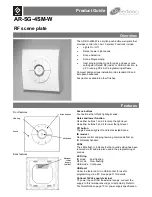Rev. 1.3
111
C8051F340/1/2/3/4/5/6/7/8/9/A/B/C/D
The level of FLASH security depends on the FLASH access method. The three FLASH access methods
that can be restricted are reads, writes, and erases from the C2 debug interface, user firmware executing
on unlocked pages, and user firmware executing on locked pages.
Accessing FLASH
from the C2 debug interface
:
1.
Any unlocked page may be read, written, or erased.
2.
Locked pages cannot be read, written, or erased.
3.
The page containing the Lock Byte may be read, written, or erased if it is unlocked.
4.
Reading the contents of the Lock Byte is always permitted.
5.
Locking additional pages (changing ‘1’s to ‘0’s in the Lock Byte) is not permitted.
6.
Unlocking FLASH pages (changing ‘0’s to ‘1’s in the Lock Byte) requires the C2 Device Erase
command, which erases all FLASH pages including the page containing the Lock Byte and the
Lock Byte itself.
7.
The Reserved Area cannot be read, written, or erased.
Accessing FLASH
from user firmware
executing on an
unlocked page
:
1.
Any unlocked page except the page containing the Lock Byte may be read, written, or erased.
2.
Locked pages cannot be read, written, or erased.
3.
The page containing the Lock Byte cannot be erased. It may be read or written only if it is
unlocked.
4.
Reading the contents of the Lock Byte is always permitted.
5.
Locking additional pages (changing ‘1’s to ‘0’s in the Lock Byte) is not permitted.
6.
Unlocking FLASH pages (changing ‘0’s to ‘1’s in the Lock Byte) is not permitted.
7.
The Reserved Area cannot be read, written, or erased. Any attempt to access the reserved
area, or any other locked page, will result in a FLASH Error device reset.
Accessing FLASH
from user firmware
executing on a
locked page
:
1.
Any unlocked page except the page containing the Lock Byte may be read, written, or erased.
2.
Any locked page except the page containing the Lock Byte may be read, written, or erased.
3.
The page containing the Lock Byte cannot be erased. It may only be read or written.
4.
Reading the contents of the Lock Byte is always permitted.
5.
Locking additional pages (changing ‘1’s to ‘0’s in the Lock Byte) is not permitted.
6.
Unlocking FLASH pages (changing ‘0’s to ‘1’s in the Lock Byte) is not permitted.
7.
The Reserved Area cannot be read, written, or erased. Any attempt to access the reserved
area, or any other locked page, will result in a FLASH Error device reset.


















